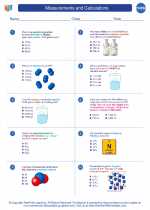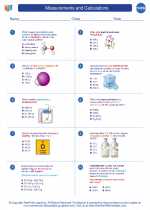Measurements and Calculations
Introduction
Chemistry relies heavily on measurements and calculations to analyze and understand the properties and behavior of matter. Understanding how to make accurate measurements and perform calculations is essential for success in chemistry.
Units of Measurement
Measurements in chemistry are typically expressed using the International System of Units (SI). Common SI units used in chemistry include:
- Mass: grams (g)
- Length: meters (m)
- Volume: liters (L)
- Time: seconds (s)
- Temperature: Kelvin (K)
Accuracy and Precision
Accuracy refers to how close a measurement is to the true value, while precision refers to how close a series of measurements are to each other. In chemistry, it is important to strive for both accuracy and precision when making measurements.
Significant Figures
Significant figures are the digits in a measurement that are known with certainty plus one digit that is estimated. When performing calculations, the result should be reported with the same number of significant figures as the least precise measurement used in the calculation.
Basic Calculations
Chemical calculations often involve basic arithmetic operations such as addition, subtraction, multiplication, and division. It is important to pay attention to units and significant figures when performing these calculations.
Dimensional Analysis
Dimensional analysis is a method used to convert units or perform calculations using conversion factors. This technique involves setting up conversion factors to cancel out units and ensure that the final answer has the correct units.
Study Guide
Here are some key concepts to focus on when studying measurements and calculations in chemistry:
- Understand the SI units commonly used in chemistry and be able to convert between different units.
- Practice determining the number of significant figures in measurements and calculations.
- Review basic arithmetic operations and their application to chemistry problems.
- Master the technique of dimensional analysis for unit conversions and calculations.
Practice Problems
Here are some practice problems to help you reinforce your understanding:
- Convert 25.0 meters to centimeters.
- Determine the number of significant figures in the measurement 0.00340 grams.
- Perform the following calculation with the correct number of significant figures: 12.5 g + 3.21 g
- Use dimensional analysis to convert 500 milliliters to liters.
Remember to review your answers and seek help if you encounter any difficulties with these problems. Practice is key to mastering measurements and calculations in chemistry!
[Measurements And Calculations] Related Worksheets and Study Guides:
.◂Chemistry Worksheets and Study Guides High School. Measurements and Calculations

 Worksheet/Answer key
Worksheet/Answer key
 Worksheet/Answer key
Worksheet/Answer key
